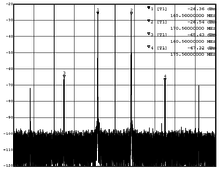Signal level difference
The signal level difference is the difference between the level of a signal and the level of a carrier ( engl. Carrier) or a reference signal. The signal level difference describes the logarithmic ratio of the signal power to the power of the reference signal.
The specification in dBc ( dB carrier ) is used in communications technology for intermodulation products and interference signals from a carrier. In communication systems, the limits of interference signals are specified both in maximum absolute levels and in dBc levels. Too high an interference signal level, equivalent to a high dBc level, can lead to interference in the signal transmission.
How big is the signal to noise ratio, in this case, the level difference between noise and support, at least must be to no influence to have the transmission depends on the used radio technology and in particular the receiver sensitivity and the analog input and possibly used digital signal filter from . A standard value is around −10 dBc. If the filters of the receiver are sharp and the frequency spacing between the carrier and the interfering signal is large enough, the interfering signal in the receiver can be suppressed to such an extent that the transmission channel is not affected even if the signal strength is greater than that of the carrier .
The designation dBc / Hz (level difference based on 1 Hz bandwidth ) is used in particular for phase noise to indicate the noise power density .
example
A carrier has a transmission power of , an interference signal a power of .
The carrier thus has a signal level of
The level of the interference signal is
The signal level difference between the interference signal and the carrier is thus calculated
The signal level difference can also be calculated directly from the logarithmic ratio of the two signal powers (interference signal in relation to the carrier):
- .
See also
literature
- Michael Dickreiter , Volker Dittel, Wolfgang Hoeg, Martin Wöhr (eds.): Manual of the recording studio technology . 8th revised and expanded edition, 2 volumes, Verlag Walter de Gruyter, Berlin / Boston 2014, ISBN 978-3-11-028978-7 .
- Andreas Friesecke: The audio encyclopedia. A reference book for sound engineers. Saur, Munich 2007, ISBN 978-3-598-11774-9 .
- Peter Bocker: data transfer technology of data and text communication. Second edition, Springer Verlag, Berlin / Heidelberg 1983, ISBN 978-3-642-81973-5 .
- Ulrich Freyer: News transmission technology. Basics, components, processes and systems of telecommunications technology . 1st edition. Carl Hanser Verlag, Munich 2009, ISBN 978-3-446-41462-4 .






